
|   |

|   |
Informed portrayals in Bharata Kalanjali's Meghadootam - Dr. S.D. Desai e-mail: sureshmrudula@gmail.com August 4, 2022 With luxuriating imagination, Kavi Kalidas's Meghadootam lights up a way of life that distinguishes the culture of India. An individual (vyakti) in it is an integral part of the universe (samashti) - Vasudhaiva Kutumbakam. Even in a sad state of mind, Yaksha thinks of and appreciates the exceptional beauty that this land and its people, particularly its womenfolk, are endowed with along the way from Ramgiri and urges his cloud messenger to enjoy it before reaching his beloved who has like himself been pining for love in Alkapuri in the Himalayas.  There is a pleasurable challenge to the choreographer for a dance drama on the mini-epic on the theme to visualize this beauty, both spread out visibly and in the hearts of the two lovers unseen and get viewers to visualize it. Dolly (Desai) Bhargav, Director of Bharata Kalanjali (Ahmedabad) on the heels of Tejaswini a month ago, portrays the theme, the land, the lovers and the womenfolk pretty well with young amateur dancers joyously participating. Equipped with the insight on the finer aspects of the mini-epic Bhagyesh Jha, a knowledgeable Sanskrit scholar gave in his preamble to the stage presentation, the viewers at the Thakorbhai Hall (July 30), most of them having a nodding acquaintance with the language, got to realize why Meghadootam is considered a gem of poetry in world literature. Kalarav as Yaksha and Dharanaa as his beloved Yakshini give cherished portrayals with a lot of understanding and dancing skills. Dharanaa, tanvi (slender) and no shyama, brings to her face including eyes and dehayashti subtly varying expressions and Kalarav in his sustained role in the seventy-minute presentation is elegant in a combination of his Bharatanatyam and Kathak skills. The Sayujya (togetherness) that they depict, particularly in the concluding segment, has a welcome touch of restraint and suggestion built into their abhinaya. Close intimacy gets portrayed in an embrace, for example, without touch. The director-choreographer's sensibility is reflected in such moments giving an aesthetic touch to the dance drama. 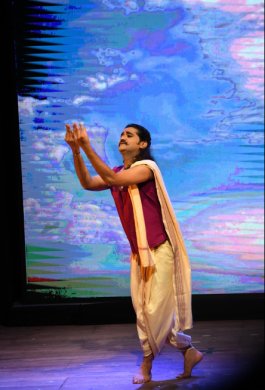 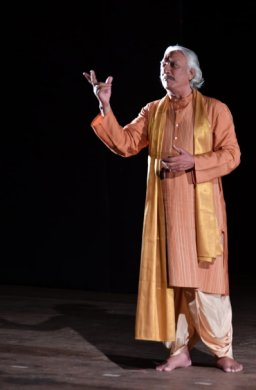 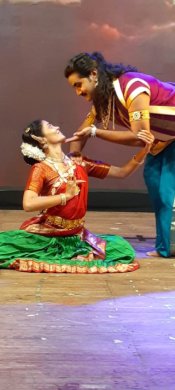 For the viewers to remain with the flow of the narrative, segment after segment, that becomes visual poetry, Bhargav as Sutradhar blends his dramatic skill occasionally with select mudras for emphasis, voice modulation and a measured gait. Six young dancers forming the Nrutyavrud (Vedanshi, Tanmayee, Pavitri, Neti, Preksha, Kinnari), endearingly pretty and strung together in action like flowers in a garland keep appearing between segments - now with the daily chores women are engaged in, now working in or off fields, now playing musical instruments, now as Nrityanganas, as janapadavadhoos. They pleasingly emulate bhramaras, birds and deer. They seem adept as much at folk dance as classical. Thirty out of a hundred and twenty shlokas of the mini-epic have been selected by Dolly Desai, who is also the script writer. Rather than trying to be comprehensive, it seems, more eminently performance-worthy shlokas have been selected so as to give a taste of the poetic work. In the light of the theme, shringara remains the overriding bhava. A balance between shringara and bhakti is sought to be created with a feel of Yaksha's visit to the Shiva Temple in Ujjain through pooja, Shivanritya (Kumar) and a soulful Mallari vocal done by Laxmi, an accomplished singer. A playful interaction between Yakshini and Mayura (Chhavi) in Alkapuri needs to be made here in passing. 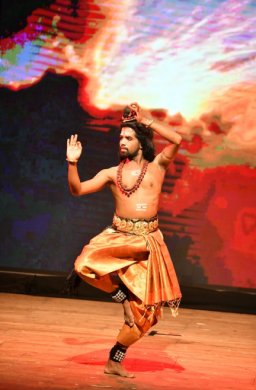 Neeraj Parikh's outstanding classical music (pre-recorded), chiefly vocal with minimum instrumental accompaniment, provides appropriate ambience of the onset of monsoon in the month of Aashadh and as much for bhakti as for shringar. Strains of Megh Malhar heard all through the performance remain in memory for long. So do the vocal renderings of aalaps and Mandakranta quatrains beginning with Aashadhyasya prathama diwase... and ending with Maa bhoodevam kshanamapi cha te vidyuta viprayogah (May you never suffer even a moment's separation from your beloved lightning!) by Neeraj, Ami and Srushti. It is a measure of the impact of this music along with the dance performances that viewers perhaps rarely preferred to be distracted by the visuals of clouds and rain flashed on the screen though they served a purpose! 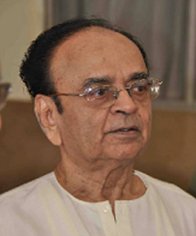 Dr. S.D. Desai, a professor of English, has been a Performing Arts Critic for many years. Among the dance journals he has contributed to are Narthaki, Sruti, Nartanam and Attendance. His books have been published by Gujarat Sahitya Academy, Oxford University Press and Rupa. After 30 years with a national English daily, he is now a freelance art writer. |